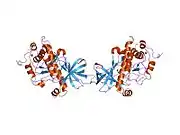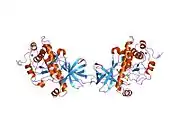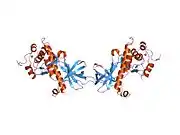Transient receptor potential cation channel, subfamily M, member 7, also known as TRPM7, is a human gene encoding a protein of the same name.
Function
TRPs, mammalian homologs of the Drosophila transient receptor potential (trp) protein, are ion channels that are thought to mediate capacitative calcium entry into the cell. TRP-PLIK is a protein that is both an ion channel and a kinase. As a channel, it conducts calcium and monovalent cations to depolarize cells and increase intracellular calcium. As a kinase, it is capable of phosphorylating itself and other substrates. The kinase activity is necessary for channel function, as shown by its dependence on intracellular ATP and by the kinase mutants.[5]
Interactions
TRPM7 has been shown to interact with PLCB1[6] and PLCB2.[6]
Clinical relevance
Defects in this gene have been associated with magnesium deficiency in human microvascular endothelial cells.[7]
See also
References
- 1 2 3 GRCh38: Ensembl release 89: ENSG00000092439 - Ensembl, May 2017
- 1 2 3 GRCm38: Ensembl release 89: ENSMUSG00000027365 - Ensembl, May 2017
- ↑ "Human PubMed Reference:". National Center for Biotechnology Information, U.S. National Library of Medicine.
- ↑ "Mouse PubMed Reference:". National Center for Biotechnology Information, U.S. National Library of Medicine.
- ↑ "Entrez Gene: TRPM7 transient receptor potential cation channel, subfamily M, member 7".
- 1 2 Runnels LW, Yue L, Clapham DE (May 2002). "The TRPM7 channel is inactivated by PIP(2) hydrolysis". Nat. Cell Biol. 4 (5): 329–36. doi:10.1038/ncb781. PMID 11941371. S2CID 21592843.
- ↑ Baldoli E, Maier JA (2012). "Silencing TRPM7 mimics the effects of magnesium deficiency in human microvascular endothelial cells". Angiogenesis. 15 (1): 47–57. doi:10.1007/s10456-011-9242-0. PMID 22183257. S2CID 16274084.
Further reading
- Chubanov V, Gudermann T, Schlingmann KP (2005). "Essential role for TRPM6 in epithelial magnesium transport and body magnesium homeostasis". Pflügers Arch. 451 (1): 228–34. doi:10.1007/s00424-005-1470-y. PMID 16075242. S2CID 6037803.
- Clapham DE, Julius D, Montell C, Schultz G (2005). "International Union of Pharmacology. XLIX. Nomenclature and structure-function relationships of transient receptor potential channels". Pharmacol. Rev. 57 (4): 427–50. doi:10.1124/pr.57.4.6. PMID 16382100. S2CID 17936350.
- Penner R, Fleig A (2007). "The Mg2+ and Mg(2+)-nucleotide-regulated channel-kinase TRPM7". Transient Receptor Potential (TRP) Channels. Handbook of Experimental Pharmacology. Vol. 179. pp. 313–28. doi:10.1007/978-3-540-34891-7_19. ISBN 978-3-540-34889-4. PMC 5663631. PMID 17217066.
External links
- TRPM7+protein,+human at the U.S. National Library of Medicine Medical Subject Headings (MeSH)
This article incorporates text from the United States National Library of Medicine, which is in the public domain.







